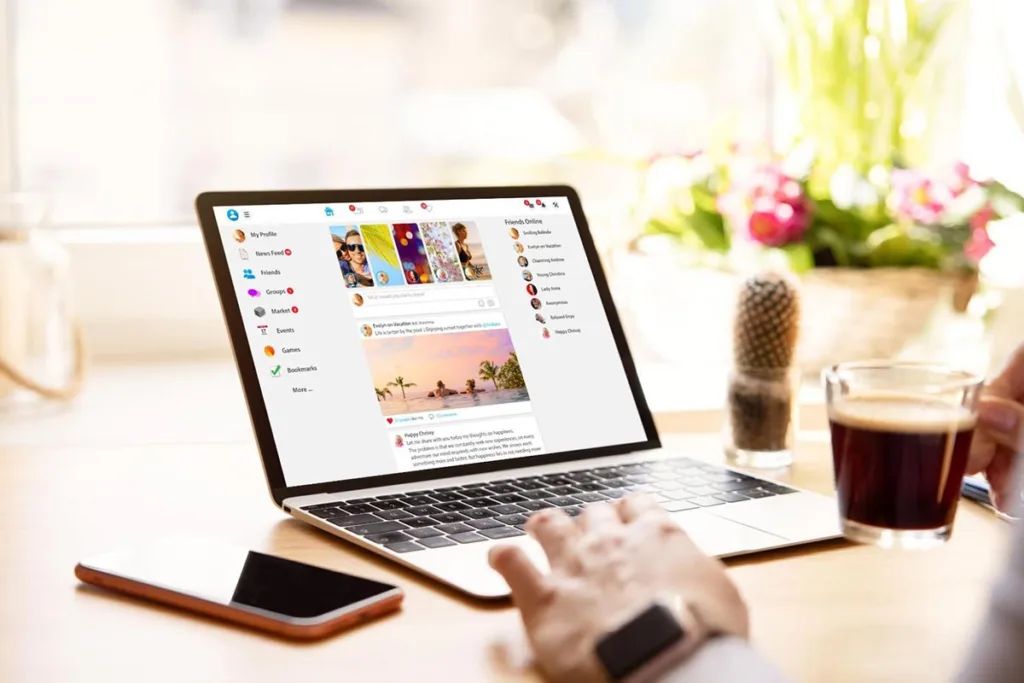Inbound lead generation: 9 tactics to boost business

Key takeaways
- Inbound lead generation focuses on helping customers discover your brand online
- Creating valuable content, like blogs, infographics, case studies, and webinars can attract traffic to your site
- Using data to qualify leads and evaluate your inbound marketing channels can make your lead generation process more successful
It’s no secret that marketers prefer inbound lead generation over outbound. It’s more effective and has a lower cost-per-lead than outbound marketing strategies. Why? Because when customers find you (inbound), they’re typically already interested in your product or service.
Companies that use inbound marketing continue to see their new leads grow. According to a 2023 Marketing Report from Foundry, “63% of buyers have visited vendor websites or contacted vendors directly” after encountering valuable content from that vendor—showing that inbound marketing tactics like content marketing hold a powerful place in your lead generation strategy.
But while inbound lead generation means potential customers will come to you, you still have work to do to reach, qualify, and convert new leads. Learn how to use inbound lead generation to reach your target audience and generate interest in your brand.
What is inbound lead generation?
Inbound lead gen is the process of attracting potential customers to your brand based on their interest in your product, service, or related topics.
These customers are looking for what you offer, and your job is to get your brand in front of them. Then you build a relationship that begins with them learning about your business, remembering your brand, returning to your website or social media accounts, interacting with your brand more often, and eventually becoming a paying customer.
Inbound marketing is an organic way to attract high-quality leads who are already interested in your product—it’s the opposite of outbound marketing where you reach out to people who may have never heard of your brand or product, and you hope someone shows an interest.
Inbound vs. outbound lead generation
Many traditional sales and marketing tactics—like cold calling and advertising—are forms of outbound lead generation.
In cold calling, for example, you might buy a list of leads with their names and phone numbers. These are called “cold leads” because they haven’t shown an interest in your service or product. If you have sales reps, they’ll call your cold leads to pitch your product. Anyone who shows an interest will then become a “warm lead.” It typically requires a lot of time and effort to generate qualified leads from cold outreach.
Traditional advertising is also a form of outbound marketing. Imagine you’re driving down the highway and you see a billboard for a fast food restaurant. Even if you’re not interested in fast food, the advertisement keeps the fast food brand top of mind. Still, out of the hundreds of people who drive by the billboard every day, only a few will likely stop at that restaurant. They weren’t seeking it so their intent to purchase was low.
Now imagine that you go online and search for “fast food near me.” You’re actively looking for fast food, so the likelihood that you will become a paying customer is much higher. You are an inbound lead or a warm lead. So when the fast food companies near you make sure they come up in the search results for “fast food near me,” they’re engaging in inbound lead generation.
Because inbound leads start as warm leads—they’re already interested in your product, industry, or topics related to your product and industry—it’s easier to convert them into sales. As such, inbound lead generation is typically a more time- and cost-effective way to attract new customers.
That’s not to say you shouldn’t engage in any outbound lead generation. Inbound marketing may attract higher-converting leads, but it also takes time to build your audience and reap the rewards of your inbound lead generation efforts. Outbound lead generation can fill the gap and ensure you still reach potential customers even when you’re not getting as many inbound leads as you’d like.
Types of leads
Even though inbound leads are already interested in your product, they might not be ready to purchase. Inbound lead generation is a process. First you attract potential customers, then you engage in lead nurturing to continue building their interest. As they become more interested, they move down your sales funnel—from discovery to engagement to purchasing.
Where potential customers are in the buyer’s journey determines what type of lead they are. Customers who have recently discovered or begun engaging with your brand are considered marketing-qualified leads (MQLs); customers who are ready to purchase are sales-qualified leads (SQLs).
Marketing-qualified lead (MQL)
Marketing-qualified leads have discovered your brand, but they might not be ready to buy. Maybe they’ve read a blog, liked a social media post, or downloaded a piece of content from your website. They now know who you are, but that doesn’t mean they want a phone call from your sales team.
The goal with a marketing-qualified lead is to continue building your relationship by offering valuable information and being a helpful resource. You can also try to entice them to move one step further down the sales funnel.
For instance, if they liked your social media post, you can promote other social media content to them in the hopes that they’ll follow your brand or visit your website. If they read a blog post, you can send them to a landing page where they can download a more in-depth piece of content by providing their email address so you can add them to your email list.
Sales-qualified lead (SQL)

A sales-qualified lead has taken a step that shows they’re not only interested in your brand but they’re also interested in buying your product. Maybe they filled out your contact form, requested a product demo, called your customer service team to ask questions, or provided their email address in exchange for a discount code.
Taking these steps shows a higher level of interest in your product and demonstrates that the lead is ready to make a purchase or get a call from you or your sales team.
The key components of an inbound lead generation strategy
There are several marketing tactics you can use to attract inbound leads. But all your inbound lead generation techniques will share a similar goal: getting your brand to show up in the right place at the right time with the right offering.
You want your brand to appear whenever someone is looking for your product or for topics related to your product. Since different members of your target audience will look for your product in different places, you need your brand to appear in a wide range of places—from search engines to social media platforms to industry events.
However, it’s not enough to just show up. You also need to offer potential customers something that makes them want to stick around and interact with your brand. That something is usually content—an answer to a question, an explanatory video, a funny meme—no matter what they were looking for.
Here are the key strategies companies use to make their brand appear when customers need it—and to offer customers a reason to engage with their brand.
Content marketing
Content marketing is the process of creating content related to your brand and product, then publishing that content online.
One of the most familiar types of content marketing is blogging. Adding a company blog allows you to answer questions about your product or service and industry.
A blog is a good way to attract new website visitors and build trust by showing off your expertise. However, it’s only one type of content. The most effective content marketing strategies include multiple types of content with each format serving a different purpose.
For example, blogs, podcasts, and video content can help customers discover your brand. More in-depth content, like webinars, e-books, and white papers can serve as lead capture tools (also called lead magnets)—where you ask customers to provide their contact information in exchange for downloading that free resource.
Other content, like case studies, can demonstrate your product’s effectiveness and help your sales team convince SQLs to become paying customers. Each type of content serves a purpose at a different point in your lead nurturing process.
Social media marketing

Social media can be an effective channel for acquiring new customers. With this in mind, it’s worth making your social media accounts a key part of your inbound lead generation efforts.
The key to getting new leads from social media marketing is to post high-quality content that’s relevant to your target audience. You can also pay to promote your content and boost its visibility.
Having accounts on multiple social media platforms will give you a wider reach so you can meet potential customers wherever they are. Be sure to keep your buyer personas in mind when you choose where to focus your social media efforts as different social media platforms attract different demographics.
For instance, if you want B2B leads and your typical clients are VPs and C-suite professionals in their 40s–60s, you’ll get better results if you focus your B2B marketing efforts on LinkedIn and Facebook than on TikTok or Snapchat. On the other hand, if your ideal customers are women in their late teens to mid-20s, then TikTok may be an essential part of your strategy.
Search engine optimization (SEO)
Search engine optimization refers to the process of getting your website to come up on search engine results pages (SERPs) on Bing, Google, and other search platforms.
Ideally, you want your business to appear near the top of search engine results anytime someone in your service area looks up topics related to your product. This brings organic traffic to your website—and organic traffic is the most effective way to bring in new website visitors. According to research by BrightEdge, 53% of website traffic comes from organic search, making it the “dominant source of trackable web traffic and the largest digital channel.”
Content marketing and social media marketing can help with your SEO strategy so these three tactics go hand-in-hand. If you serve a specific area, you can improve your local SEO to ensure your business comes up in local search results by including your company’s address on every page of your website, and on your other online profiles like your social media and Yelp Business Page.
Creating landing pages for each of your product offerings and writing blogs about keywords related to your product will also help your website come up on SERPs. Linking to your website from all of your online profiles, including your social media and Yelp Page, will help your site rank as well.
In addition to earning organic traffic through SEO, you can use pay-per-click (PPC) advertisements to bring paid traffic to your site. PPC advertising places your business in strategic locations on SERPs.
For example, Yelp Ads puts your business in key places on Yelp.com and the Yelp mobile app, such as above or below relevant search results in the “Sponsored Results” sections and on your competitors’ pages. You can target users by keyword and location, and you only have to pay if a potential customer actually clicks on your company’s ad.
Partner marketing
Partner marketing can be a grassroots or a digital marketing effort. To use this inbound marketing strategy, you’ll team up with another business or an online influencer who has a similar target audience as you but a different product offering.
For example, a wedding photographer could partner with a wedding venue, florist, or caterer. A dog groomer could partner with a veterinarian, doggy daycare, or dog walker.
If you’ve partnered with another business, you can cross-promote each other’s brands by listing them on your websites as recommended vendors. Or you can actively recommend each other to clients.
Influencer marketing involves partnering with a person who has a social media following that closely aligns with your target audience. That person agrees to promote your brand and product on their social media networks in exchange for money or free products.
You can partner with influencers of all sizes from nano-influencers with an audience of 1,000–9,999 to mega-influencers with 1,000,000 followers or more. The more followers an influencer has, the more it will cost to partner with them.
According to the Harvard Business Review, influencer marketing leads to increased engagement—and it’s no surprise that choosing influencers with more followers can have a 9.2% higher ROI than partnering with influencers who have fewer followers. With their larger reach comes more popularity and credibility, which ultimately leads to more engagement.
Event marketing

While the majority of inbound lead generation campaigns are focused on online marketing channels, that’s not the only way to reach new customers. Hosting or participating in events that are relevant to your product or service can also help you connect with potential customers on a grassroots level.
For example, a company that installs windows might participate in a home building or renovation expo while a yoga studio could host or participate in a community wellness fair. As long as the event closely aligns with your offerings, it can help bring in potential customers who are interested in topics related to your business.
9 tactics to improve your inbound lead generation strategy
Now that you understand the components of an inbound lead generation strategy, you can optimize your marketing efforts to bring in more leads and increase your conversion rates. Here’s where to start.
1. Create lead magnets
A lead magnet is an exclusive, high-quality piece of content that potential customers can only get from you. It needs to be relevant content for your audience, and it should include in-depth information that shows your company’s expertise in your industry.
E-books, white papers, and webinars are all examples of the type of content that is in-depth enough to serve as a lead magnet. Once you’ve created the content, you’ll put it behind a “gate.” In this case, the gate is a contact form.
Your website visitors have to provide you with their contact information to unlock the gate and get access to your content. This helps you grow your list of MQLs and build your email list.
Make a landing page for each of your lead magnets with a call to action (CTA) for your website visitors to download the content. Then you can link to your lead magnet landing page from your top-of-the-sales-funnel content, like your social media posts and blog.
2. Optimize your landing pages
Social media posts, blogs, podcasts, YouTube channels—all of that content helps introduce potential customers to your brand. However, landing pages convert leads into paying customers. They’re one of your most valuable tools for converting inbound leads.
You should have a landing page for each of your product offerings, services, or product features. Each landing page should clearly explain the value of your offering and include a CTA—and it should include all of this information above the fold, meaning customers can read it without scrolling.
The CTA can be anything that makes sense for your product. It might be to schedule a demo or make an appointment with your sales team. It might be to download a lead magnet or share their email address in exchange for a coupon.
You should also make sure the landing page is eye-pleasing, easy to read, and uncluttered.
3. Use marketing automation

Over 94% of marketers who use automation software say they benefit from it—some of the most common benefits include saving time, allowing more time to work on other more valuable or enjoyable tasks, and completing projects faster; 37% say they use automation to quickly follow up with leads, according to a survey from Zapier.
Marketing automation is essential for lead nurturing. Using “if this, then that” logic, you can set up automation to send out email marketing campaigns when a new lead takes a certain action.
For instance, if a website visitor shares their contact information in one of your lead magnets, you can send an email drip campaign to introduce them to your brand, share relevant content, and keep them engaged. If they buy their first product, you can send an automated thank you email or a “getting started” email to help them make the most of their purchase.
Marketing automation ensures no lead gets left behind, and it matches each lead with content that’s relevant to where they are in the buyer’s journey.
4. Personalize your communication
The fastest way to lose an inbound lead is to bombard them with content that isn’t relevant to them. So whenever your leads share their contact information, it helps to include a couple of extra questions on your form.
You can ask what topics they’re most interested in or what field they work in (if you run a B2B company). Then segment your email list based on your leads’ interests and only send them emails about the topics they care about. Make sure your email marketing is also set up to include each customer’s name in the introduction of your emails.
Personalization helps build a relationship that can make new leads more interested in becoming customers.
5. Use lead scoring
Lead scoring is a data-driven approach to qualifying leads. It helps your marketing and sales teams get a better understanding of where each of your leads is in the sales funnel, which then helps them send each lead more relevant and personalized communication.
To score leads, you will assign them a certain number of points for each action they take on your website and other online platforms. For example, they might get 5 points for liking a social media post, 10 points for following you on social media, 15 points for downloading a lead magnet, 100 points for scheduling a consultation with your sales team, and 250 points for buying one of your products.
The number of points you assign to each action is up to you. But you will need your marketing and sales team to align on how many points each action is worth so you can be consistent in your lead scoring.
You’ll also need to agree on points thresholds that move each customer further down the sales funnel. For example, maybe a customer who only has 25 points is near the top of the sales funnel so they receive marketing materials with educational content. Once they reach 100 points, perhaps you start sending them more sales-oriented marketing materials, like emails about your product features.
6. Take a multichannel approach
With an inbound lead generation strategy, you can bring in inbound leads from online search engines, social media platforms, and in-person events. To attract the largest number of inbound leads, you should do all three.
The goal of inbound marketing focuses on meeting potential customers wherever they are, which means you need to be wherever they are. To do that, market on as many channels as you have the resources to handle. If your resources are limited, it’s better to publish high-quality content less often than to publish low-quality content more frequently.
When you create your content marketing strategy, think about creating multiple types of content or repurposing your content to use on multiple channels. For example, you can create a video, turn the audio from it into a podcast, and transcribe that audio to create a blog post. Now you’ve covered three content channels instead of one. You can also use snippets of that content on your social media accounts with links back to your website.
You should also create accounts on all relevant social media platforms and online business platforms. For instance, after you’ve claimed your Yelp Business Page, continue to fill out or update your business information and upload high-quality photos. This will improve your SEO and build trust with potential customers who discover you through these sites.
7. Publish case studies and success stories
To continue building trust with new leads, demonstrate the value of your product or service by creating a case study. For a case study, you’ll feature a satisfied customer and ask about their experience. Discuss the problem that the customer had and how your product or services solved their problem.
You can write a case study or conduct a video- or audio-based interview. Case studies typically aren’t how inbound leads discover your brand, but they can demonstrate the value of your product and help move your inbound leads further down the sales funnel.
Once a lead is sales-qualified, case studies will also help your sales team close the deal by providing evidence that your product works.
8. Measure your inbound lead generation ROI

One of the most difficult things about creating an inbound lead generation strategy is measuring its success.
Track your return on investment (ROI) based on how many leads you’re able to bring in and convert. That said, you should also monitor other success metrics, like the number of likes, comments, and shares your social media posts get, or the amount of organic traffic a certain blog post brings in.
You can use UTM codes—a snippet of code that you add to the end of a line—to track your webpage visits and see where most of your traffic is coming from, as well as how they’re moving around your site. For instance, if they visited a blog post, did they click any other links and read any of your other content or visit a landing page?
Data is your friend. All of these metrics will help you understand how successful your inbound lead generation strategy is, which tactics are working, and which ones aren’t.
9. Adapt and improve
Once you know what’s working and what isn’t, make changes. Don’t think of your inbound lead generation strategy as a static thing. Think of it as an ever-evolving approach to learn about your customers and better serve them.
If you discover that influencer marketing is bringing in a lot of new leads while podcasting isn’t, you can shift your marketing budget and strategy to include more influencer marketing and less podcasting. If one social media post brings in three times more traffic than any other, you can promote that post to reach even more customers.
If no one is downloading your e-book but everyone is downloading your webinar, you can host more webinars in the coming year. You can also create multiple versions of the same landing page and conduct A/B testing to find out which one is better at converting website visitors into qualified leads.
Inbound marketing is about meeting your customers where they are and giving them what they want. So as you learn more about what your customers want, do more of it.
Find your strategy so customers can find you
A sales team’s dream is to know that every lead they speak to is already interested in what they’re selling. Inbound lead generation makes that dream come true as the people who need your product will come to you.
While this strategy doesn’t require the same type of customer outreach as outbound lead generation, you (or your marketing team) will still have plenty of work to do. The best inbound lead generation strategies are multichannel approaches that combine content marketing, social media marketing, and search engine optimization. Learn more about how to use SEO for lead generation.
The information above is provided for educational and informational purposes only. It is not intended to be a substitute for professional advice and may not be suitable for your circumstances. Unless stated otherwise, references to third-party links, services, or products do not constitute endorsement by Yelp.



